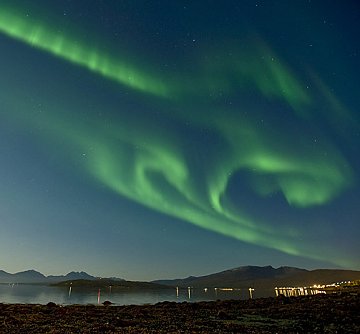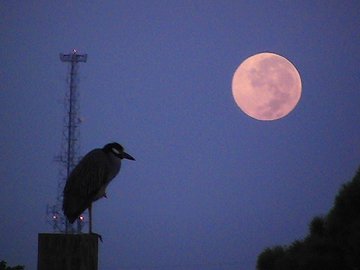| JULES VERNE: Two weeks from now, on Sept 29th, ESA's Jules Verne spacecraft will re-enter Earth's atmosphere and disintegrate as a fireball over the south Pacific Ocean. Until then, the doomed ship is circling Earth in plain view of sky watchers. This movie of Jules Verne gliding by Polaris (the North Star) was recorded on Sept. 10th by Kevin Fetter of Ontario, Canada. People in North America and Europe are favored with plenty of similar passes in the week ahead. Check the Simple Satellite Tracker for viewing times. more images: from Thomas Dorman of Horizon City,Texas; from John C McConnell of Maghaberry, Northern Ireland. AURORA WATCH: A solar wind stream is buffeting Earth's magnetic field and causing geomagnetic storms around the Arctic Circle. "The auroras were visible tonight (Sept. 14) in spite of twilight and bright moonlight," says Bjorn Jorgensen, who sends this picture from Tromso, Norway: 
Also in Tromso, Martin Ratcliffe reports activity lasting more than two hours "with a five minute period of especially intense curtains dancing across the entire sky." More storms are in the offing as the solar wind continues to blow. Sky watchers from Alaska to Scandinavia should be alert for auroras. Sept. 2008 Aurora Gallery
[Aurora Alerts] [Night Sky Cameras] MOONSET: According to research, Herons are among the most intelligent birds. This one in Seminole, Florida, was smart enough to wake up at dawn to watch the setting of the Harvest Moon: 
"We had a clear morning for a change," says photographer David Dickinson. "Walking down to the dock, I started shooting the setting Harvest Moon when I noticed that a Heron was posing on a pylon for me! Together we watched the Moon until sunrise." The Harvest Moon is the full moon closest to the autumnal equinox (Sept. 22). Before electric lights, farmers relied on Harvest moonlight to help them gather ripening crops late into the night. Now, post-Edison, we appreciate it mainly for its beauty. Browse the photos below for a sampling. more images: from Lukas Gornisiewicz near Medicine Hat, Alberta, Canada; from Yasmin Angelique Walter of S. Eularia, Ibiza, Baleares, Spain; from Quintus Oostendorp of Vaassen, the Netherlands; from Peter von Bagh of Porvoo, Finland; from P-M Hedén of Hedesunda, Sweden; from Yuichi Takasaka of Lumby, British Columbia, Canada; from Sam Cole of Austin, Texas; from Bob King of Duluth, Minnesota; from Jari Kankaanpaa of Lake Ojutjarvi, Kauhava, Finland; | 
